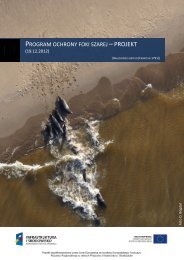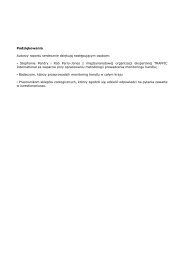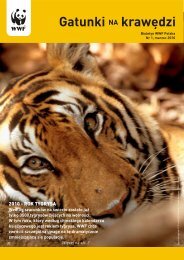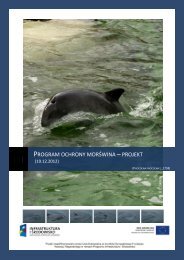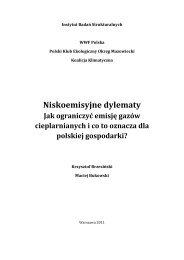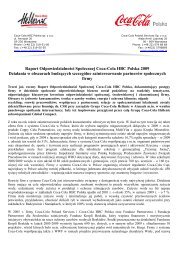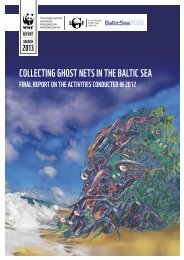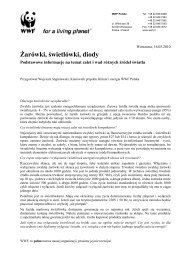Compared to 2010 there are:• 6 per cent more species <strong>and</strong> 13 per cent more populations inthe global LPI;• 7 per cent more terrestrial species <strong>and</strong> 19 per cent moreterrestrial populations;• 6 per cent more marine species <strong>and</strong> 18 per cent moremarine populations;• 3 per cent more freshwater species <strong>and</strong> 4 per cent morefreshwater populations.These changes have improved the spread of the data amongdifferent regions <strong>and</strong> different taxa also. There is a <strong>better</strong> balancebetween tropical <strong>and</strong> temperate species; for example, tropicalspecies now account for 47 per cent of the species in the indexcompared to 41 per cent in 2010. Each of the taxa is <strong>better</strong>represented; for example, reptile species have increased by thegreatest proportion at 39 per cent. Increasing the dataset in thisway generally improves the robustness of the indices <strong>and</strong> usuallyproduces smoother trends.Methodology changesThe method used to calculate the LPI has remained unchangedsince 2008 (see Collen et al., 2009 for more details).Number of populations1000090008000700060005000400030002000Living PlanetReport 20061,313 SpeciesLiving PlanetReport 20081,686 SpeciesMar 06Jun 06Sep 06Dec 06Apr 07Jul 07Oct 07Jan 08May 08Aug 08Living PlanetReport 20102,544 SpeciesNov 08Mar 09Jun 09Sep 09Dec 09Apr 10Jul 10Oct 10Feb 11May 11Living PlanetReport 20122,688 SpeciesAug 11Nov 11Figure 59: Thecumulative number ofpopulation time seriesin the LPI databaseAnnex 2: EcologicalFootprint: Frequentlyasked questionsHow is the Ecological Footprint calculated?The Ecological Footprint measures the amount of biologicallyproductive l<strong>and</strong> <strong>and</strong> water area required to produce the resources anindividual, population or activity consumes <strong>and</strong> to absorb the wasteit generates, given prevailing technology <strong>and</strong> resource management.This area is expressed in global hectares (hectares with worldaveragebiological productivity). Footprint calculations use yieldfactors to normalize countries’ biological productivity to worldaverages (e.g., comparing tonnes of wheat per UK hectare versus perworld average hectare) <strong>and</strong> equivalence factors to take into accountdifferences in world average productivity among l<strong>and</strong> types (e.g.,world average forest versus world average cropl<strong>and</strong>).Footprint <strong>and</strong> <strong>biocapacity</strong> results for countries are calculatedannually by the Global Footprint Network. Collaborations withnational governments are invited, <strong>and</strong> serve to improve the data<strong>and</strong> methodology used for the National Footprint Accounts. To date,Switzerl<strong>and</strong> has completed a review, <strong>and</strong> Belgium, Ecuador, Finl<strong>and</strong>,Germany, Irel<strong>and</strong>, Japan <strong>and</strong> the UAE have partially reviewedor are reviewing their accounts. The continuing methodologicaldevelopment of the National Footprint Accounts is overseen by aformal review committee. A detailed methods paper <strong>and</strong> copies ofsample calculation sheets can be obtained fromwww.footprintnetwork.orgFootprint analyses can be conducted at any scale. Thereis growing recognition of the need to st<strong>and</strong>ardize sub-nationalFootprint applications in order to increase comparability acrossstudies <strong>and</strong> longitudinally. Methods <strong>and</strong> approaches for calculatingthe Footprint of municipalities, organizations <strong>and</strong> products arecurrently being aligned through a global Ecological Footprintst<strong>and</strong>ards initiative. For more information on Ecological Footprintst<strong>and</strong>ards see www.footprintst<strong>and</strong>ards.orgWWF Living Planet Report 2012 page 134 Annex: Technical notes <strong>and</strong> data tables page 135
What is included in the Ecological Footprint?What is excluded?To avoid exaggerating human dem<strong>and</strong> on nature, the EcologicalFootprint includes only those aspects of resource consumption <strong>and</strong>waste production for which the Earth has regenerative capacity, <strong>and</strong>where data exists that allow this dem<strong>and</strong> to be expressed in terms ofproductive area. For example, toxic releases are not accounted forin Ecological Footprint accounts. Nor are freshwater withdrawals,although the energy used to pump or treat water is included.Ecological Footprint accounts provide snapshots of pastresource dem<strong>and</strong> <strong>and</strong> availability. They do not predict the future.Thus, while the Footprint does not estimate future losses causedby current degradation of ecosystems, if this degradation persistsit may be reflected in future accounts as a reduction in <strong>biocapacity</strong>.Footprint accounts also do not indicate the intensitywith which a biologically productive area is being used. Being abiophysical measure, it also does not evaluate the essential social<strong>and</strong> economic dimensions of sustainability.How is international trade taken into account?The National Footprint Accounts calculate the Ecological Footprintassociated with each country’s total consumption by summingthe Footprint of its imports <strong>and</strong> its production, <strong>and</strong> subtractingthe Footprint of its exports. This means that the resource use <strong>and</strong>emissions associated with producing a car that is manufactured inJapan, but sold <strong>and</strong> used in India, will contribute to India’s ratherthan Japan’s consumption Footprint.National consumption Footprints can be distorted when theresources used <strong>and</strong> waste generated in making products for exportare not fully documented for every country. Inaccuracies in reportedtrade can significantly affect the Footprint estimates for countrieswhere trade flows are large relative to total consumption. However,this does not affect the total global Footprint.How does the Ecological Footprint account for theuse of fossil fuels?Fossil fuels such as coal, oil <strong>and</strong> natural gas are extracted fromthe Earth’s crust <strong>and</strong> are not renewable in ecological time spans.When these fuels burn, carbon dioxide (CO2) is emitted into theatmosphere. There are two ways in which this CO2 can be stored:human technological sequestration of these emissions, such asdeep-well injection, or natural sequestration. Natural sequestrationoccurs when ecosystems absorb CO2 <strong>and</strong> store it either in st<strong>and</strong>ingbiomass, such as trees, or in soil.The Carbon footprint is calculated by estimating how muchnatural sequestration would be necessary to maintain a constantconcentration of CO2 in the atmosphere. After subtracting theamount of CO2 absorbed by the oceans, Ecological Footprintaccounts calculate the area required to absorb <strong>and</strong> retain theremaining carbon based on the average sequestration rate of theworld’s forests. CO2 sequestered by artificial means would also besubtracted from the Ecological Footprint total, but at present thisquantity is negligible. In 2008, 1 global hectare could absorb theCO2 released by burning approximately 1,450 litres of gasoline.Expressing CO2 emissions in terms of an equivalentbioproductive area does not imply that carbon sequestrationin biomass is the key to resolving global climate change. On thecontrary, it shows that the biosphere has insufficient capacityto offset current rates of anthropogenic CO2 emissions. Thecontribution of CO2 emissions to the total Ecological Footprintis based on an estimate of world average forest yields. Thissequestration capacity may change over time. As forests mature,their CO2 sequestration rates tend to decline. If these forests aredegraded or cleared, they may become net emitters of CO2.Carbon emissions from some sources other than fossil fuelcombustion are incorporated in the National Footprint Accountsat the global level. These include fugitive emissions from the flaringof gas in oil <strong>and</strong> natural gas production, carbon released by chemicalreactions in cement production <strong>and</strong> emissions from tropicalforest fires.How does the Ecological Footprint account forcarbon emissions absorbed by the oceans versusuptake by forests?The National Footprint Accounts calculate the Carbon Footprintby considering sequestration from the world’s oceans <strong>and</strong> forests.Annual ocean uptake values are taken from Khatiwala et al., 2009(ref: Khatiwala, S. et al., 2009. Reconstruction of the history ofanthropogenic CO2 concentrations in the ocean. Nature 462, 346-350) <strong>and</strong> used with the anthropogenic carbon emissions taken fromCDIAC (CDIAC, 2011). There is a relatively constant percentageuptake for oceans, varying between 28 per cent <strong>and</strong> 35 per cent overthe period 1961-2008. The remaining CO2 requires l<strong>and</strong> basedsequestration. Due to the limited availability of large-scale datasets,the calculation currently assumes the world average sequestrationrate for uptake of carbon dioxide into forests. Therefore the CarbonFootprint is a measure of the area of world average forest l<strong>and</strong> thatis necessary to sequester the carbon dioxide emissions that are notabsorbed into the world’s oceans.WWF Living Planet Report 2012 page 136 Annex: Technical notes <strong>and</strong> data tables page 137



